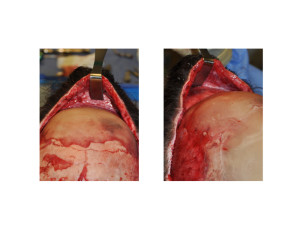
Female forehead augmentation can be done using a variety of different materials from bone cements to preformed and custom silicone implants. The choice of which material method to use depends on a variety of factors not the least of which is the amount of augmentation needed and the type of incisional approach to be used. With a completely open approach to forehead augmentation a viable option is that of bone cements. Such visual access allows for good cement application and shaping which is a critical part of intraoperatively applied onlay materials.
Before custom forehead implants became a treatment option, the gold standard for female forehead augmentation was the use of PMMA bone cements. This is still a useful material choice but does require a scalp incision of some length. A hairline or pretrichial incision can be used if one is also moving the hairline or one can tolerate the location of the scar. The further back in the hairline one goes the longer the scalp incision must be to provide adequate access for cement application and shaping.
Case Study: This 25 year old female wanted to create a better forehead shape. She felt her forehead sloped back too far and wanted more projection, particularly in the central part of the forehead. She already had a coronal scalp incision/scar from a prior procedure.


Highlights:
1) The ideal shape of the female forehead is that of a more convex shape without brow bone prominences and a near vertical orientation.
2) Female forehead augmentation can be done using bone cements but require a more open scalp incisional approach to do so.
3) A coronal scalp approach to a female forehead augmentation is best reserved for those women having other skull procedures or who already have a full coronal scalp scar.
Dr. Barry Eppley
Indianapolis, Indiana



